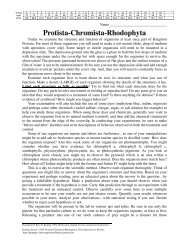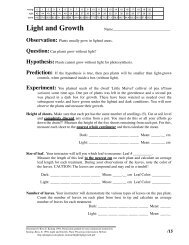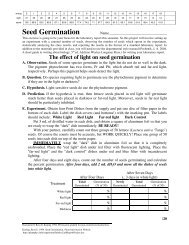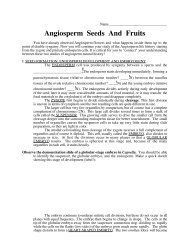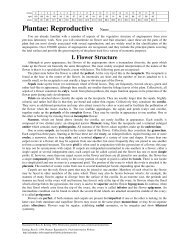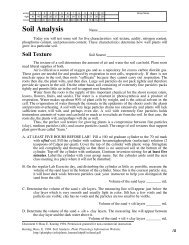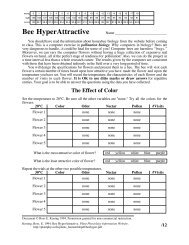Flower Morphology - Home Page for Ross Koning
Flower Morphology - Home Page for Ross Koning
Flower Morphology - Home Page for Ross Koning
Create successful ePaper yourself
Turn your PDF publications into a flip-book with our unique Google optimized e-Paper software.
wrong 0 1 2 3 4 5 6 7 8 9 10 11 12 13 14 15 16 17 18 19 20<br />
right 84 83 82 81 80 79 78 77 76 75 74 73 72 71 70 69 68 67 66 65 64<br />
score 100 98.8 97.6 96.4 95.2 94.0 92.9 91.7 90.5 89.3 88.1 86.9 85.7 84.5 83.3 82.1 81.0 79.8 78.6 77.4 76.2<br />
<strong>Flower</strong> <strong>Morphology</strong> <br />
Name _______________________________<br />
You are already familiar with a number of aspects of the vegetative structure of<br />
angiosperms from your previous laboratory work. Now you will concentrate on flower structure,<br />
since these are the parts of the plant that are most closely associated with sexual reproduction,<br />
and are widely used in the classification of the angiosperms. Over 250,000 species of<br />
angiosperms are recognized, and they include the principal plants covering the land surface and<br />
provide the great majority of the plants used <strong>for</strong> a variety of economic purposes.<br />
<strong>Flower</strong> Structure<br />
Although in gross appearance, the flowers of the angiosperms show a tremendous<br />
diversity, the parts which make up the flower are basically the same throughout. The most widely<br />
accepted interpretation of the nature of the flower is that it is a specialized branch; a stem with<br />
leaves. The flower has many parts.<br />
The plant stem below the flower is called the pedicel. At the very tip of this is the<br />
receptacle. The receptacle is the stem portion of the flower. It is found at the base in the center of<br />
the flower. Its internodes are short and the number of leaves is usually small, so the receptacle is<br />
not usually a large or obvious part of the flower.<br />
Sepals make up the lower (or outermost) whorl of floral leaves. They are frequently, but<br />
not always, green and rather leaf-like in appearance, although they usually are smaller than the<br />
foliage leaves of the plant. Collectively, all sepals of a flower constitute the calyx. The major<br />
function appears to be protection of the flower parts from herbivores during early development.<br />
Petals are attached above (inside) the sepals on the receptacle. They are usually larger<br />
than the sepals, brightly colored, and rather leaf-like in that they are broad and rather thin organs.<br />
Collectively they constitute the corolla. They serve as additional protection against herbivores in<br />
the bud stage, and also attract insects and/or facilitate the pollination of the flower when the<br />
insect reaches it. The two leaflike appendages, the sepals and petals (calyx and corolla), together<br />
make up the perianth of a complete flower. They may be similar in appearance to one another, or<br />
one or the other or both may be missing from an incomplete flower.<br />
Stamens, which are found above (inside) the corolla, are rarely leaflike in appearance.<br />
Each usually is composed of two distinct parts: an elongated narrow filament rising from the<br />
receptacle and a terminal enlarged anther which contains many pollen grains. All stamens of the<br />
flower, taken together, make up the androecium.<br />
One or more carpels, are located in the center (top) of the flower. Collectively they<br />
constitute the gynoecium. Each carpel has three parts. Starting at the base these are: the ovary,<br />
an enlarged hollow region bearing one or more ovules; a narrower, short to long style; and a<br />
terminal stigma of various sizes and shapes. If more than one carpel occurs in a flower, all may<br />
be separate from one another, but more frequently they are joined to one another to <strong>for</strong>m a<br />
compound structure. The term pistil is often used in conjunction with the gynoecium of a flower;<br />
this may or may not be synonymous with carpel. If carpels are not fused to one another in a<br />
flower, then each carpel can be called a pistil and the flower has one or more simple pistils. If,<br />
however, more than one carpel occurs in the flower and these are all joined to one another, the<br />
flower has a single compound pistil. The cavity in the ovary portion of carpel or pistil is called<br />
the locule. There is one locule in a simple pistil and one or more in a compound pistil. The<br />
portion of the ovary to which the ovule is attached is the placenta. The number of ovules varies<br />
from one to several hundred per locule, depending upon the species.<br />
Document © <strong>Ross</strong> E. <strong>Koning</strong> 1994. Permission granted <strong>for</strong> non-commercial instruction.<br />
<strong>Koning</strong>, <strong>Ross</strong>. E. 1994. <strong>Flower</strong> <strong>Morphology</strong>. Plant Physiology In<strong>for</strong>mation Website.<br />
http://plantphys.info/plants_human/labpdf/flowermorphology.pdf
<strong>Page</strong> 2<br />
Carpels are not the only flower parts that may be joined to one another. Members of each<br />
whorl in the flower may be fused to other members of the same whorl. There may also be fusion<br />
between whorls; <strong>for</strong> example, the stamens of many flowers appear to diverge from the surface of<br />
the corolla. In an extreme case, the perianth and stamens are fused to the ovary wall and become<br />
free from it only at the top of the ovary. In flowers where the floral whorls diverge below the<br />
gynoecium, the ovary is said to be superior and the flower hypogynous. In contrast, when the<br />
free floral whorls arise from the top of the ovary, the ovary is called inferior and the flower<br />
epigynous. An intermediate condition can be found in which the several floral whorls are<br />
attached around the middle of the ovary; such a flower is called perigynous.<br />
<strong>Flower</strong>s are perfect, if both stamens and carpels are present but imperfect if one or the<br />
other is lacking. In the latter case, both staminate and carpellate flowers may occur on the same<br />
plant (monoecious) or may be on separate plants (dioecious). <strong>Flower</strong>s may be regular, exhibiting<br />
radial symmetry, or be irregular and show bilateral symmetry. Note, that in a longitudinal<br />
section such as the one below, it is not possible to be sure of the symmetry!<br />
Use as many of the terms in bold type in the description above as possible to label the<br />
longitudinal section below (there should be at least 24 labels!):<br />
/24
<strong>Page</strong> 3<br />
Dissecting Alstroemeria <strong>Flower</strong>s<br />
Examine one of the flowers provided; draw and label the flower below to show all parts and their<br />
relation to one another. Then answer the following questions about your flower:<br />
What is the symmetry of your flower radial bilateral .<br />
Are both calyx and corolla present yes no .<br />
<br />
The sepals are: free fused . The petals are: free fused .<br />
How many sepals are there _____ Petals _____ Stamens _____ Pistils_____<br />
Where are the stamens in relation to the sepals and petals ___________________<br />
If one, the pistil is: simple compound .<br />
If compound, of how many carpels is it composed _______<br />
How did you determine this I counted the ______________and ______________<br />
The ovary is: superior inferior .<br />
:<br />
The flower is: hypogynous perigynous epigynous .<br />
:<br />
How many ovules are there one less than 20 many .<br />
Where is/are the placenta(e) to which they are attached axile radial parietal .<br />
Give the complete flower <strong>for</strong>mula <strong>for</strong> your flower (8 pts): ________________--___________<br />
Diagram and label your flower in the space provided below. Use as many structure name labels as<br />
possible based upon the description on pages 1 and 2 (16 labels required).<br />
/41
<strong>Page</strong> 4<br />
Sex and Development in the <strong>Flower</strong><br />
THE POLLEN GRAIN. Look carefully at the stamen of the flower.<br />
How many anther sacs do you find ________<br />
In most species there are four, one in each corner of the anther, but at maturity the two in<br />
each half fuse. Cells produced in the anther sacs divide by meiosis to produce four microspores<br />
each. These separate from one another and each divides once by mitosis to produce a pollen<br />
grain composed of a tube cell and a smaller generative cell within the pollen wall. It is at this<br />
stage that the anther sac opens, most often longitudinally, and the pollen is shed.<br />
Observe the demonstration slide showing a cross section of a Lilium anther containing mature<br />
pollen grains.<br />
How can you distinguish the tube nucleus from the generative nucleus<br />
The tube nucleus is __________________________________________________<br />
The generative nucleus is _____________________________________________<br />
Examine fresh pollen from one of the flowers in the lab.<br />
In the space below, sketch a diagram of the pollen grain (from a prepared slide) and label it<br />
completely.<br />
THE EMBRYO SAC.<br />
The carpel bears ovules which consist of one or two protective integuments which meet<br />
at the tip, leaving a narrow opening or micropyle. The ovule is connected to the ovary by means<br />
of a stalk, the funiculus. Inside the integument, meiosis has taken place and an haploid embryo<br />
sac develops within. This is organized into seven cells: three cells at the micropylar end (two<br />
synergids and one egg), three antipodal cells at the opposite end, and the one central cell<br />
containing two polar nuclei.<br />
/8
<strong>Page</strong> 5<br />
Observe the demonstration slide(s) of the ovule and embryo sac in Rhododendron and, in the<br />
space below, sketch a diagram of the ovule with embryo sac and label completely. Place your<br />
labels <strong>for</strong> the integument, micropyle, and funiculus on the left side of the diagram. Place your<br />
labels <strong>for</strong> the parts of the embryo sac on the right side.<br />
POLLINATION AND SPERM PRODUCTION.<br />
When the pollen grain is shed from the anther, it is carried (usually by insect, bird, or<br />
wind) to the stigma of a carpel. The pollen grain germinates there, sending out the tube cell,<br />
which grows through the tissues of the stigma and style to reach the ovary.<br />
Keeping in mind the very small size of the pollen grain, and its non-green color, what is<br />
the source of nutrition of the pollen tube<br />
_______________________________________________________________________<br />
The nuclei remain near the tip of the pollen tube as it passes through the style, and the<br />
generative nucleus undergoes mitosis to <strong>for</strong>m two sperm nuclei. On reaching the ovary,<br />
the pollen tube enters an ovule via the micropyle, penetrating a synergid and there<br />
bursting at the tip. The two sperm nuclei are discharged.<br />
SYNGAMY.<br />
One of the two sperm nuclei moves to the egg cell and fuses with its nucleus to <strong>for</strong>m the<br />
zygote. The second sperm nucleus fuses with the two polar nuclei in the central cell to <strong>for</strong>m a<br />
primary endosperm cell. This double syngamy is characteristic of all angiosperms.<br />
If each nucleus in the syngamy has one set of chromosomes,<br />
how many sets would be found in the zygote __________<br />
How many sets of chromosomes would be found in<br />
Observe the demonstration slide showing double syngamy in Lilium.<br />
the primary endosperm cell __________<br />
The primary endosperm cell, the zygote, and the rest of the ovule <strong>for</strong>m the seed, a subject <strong>for</strong><br />
future study.<br />
/11




